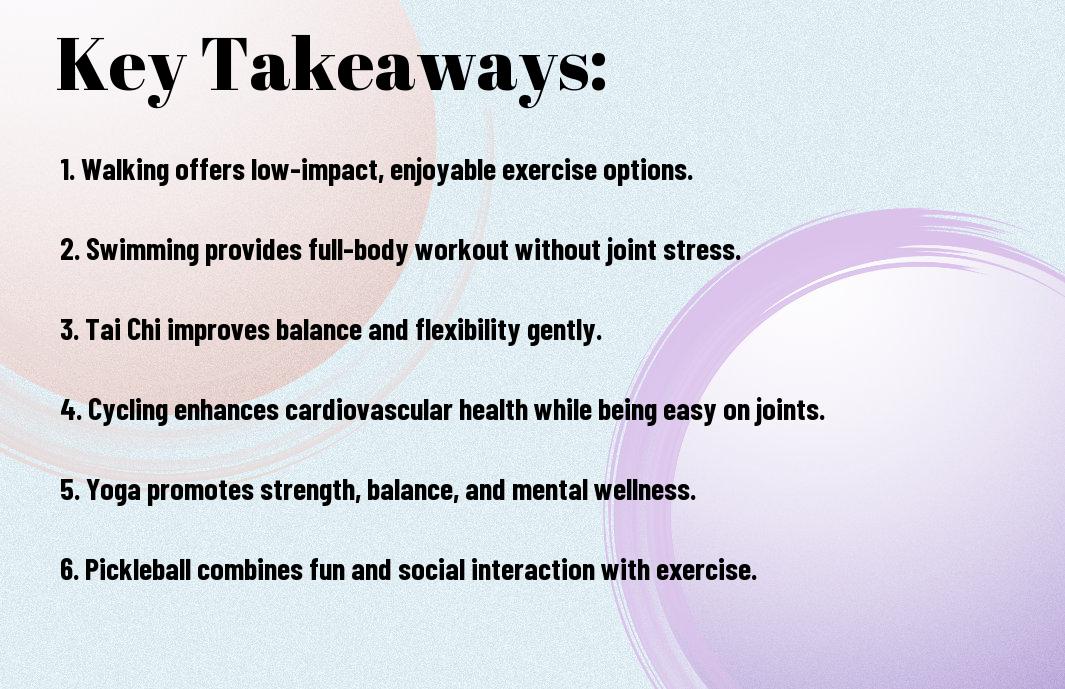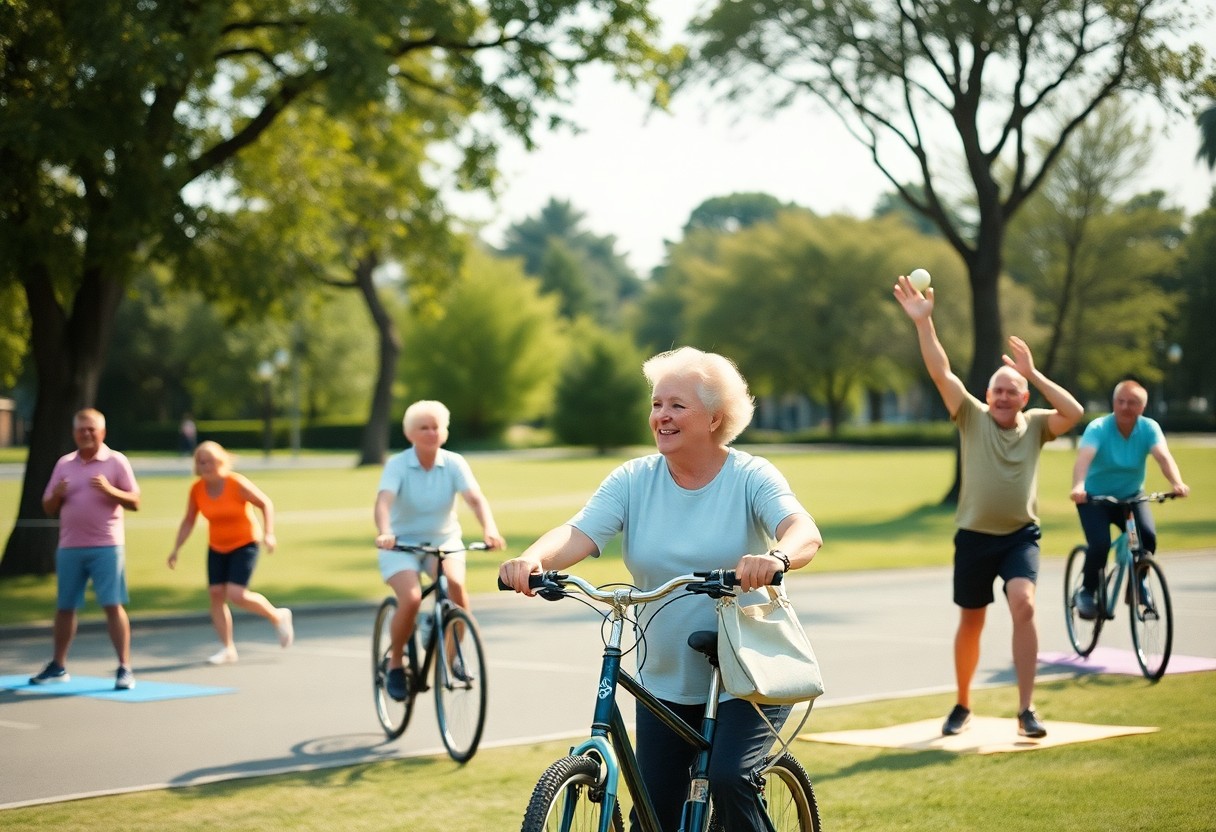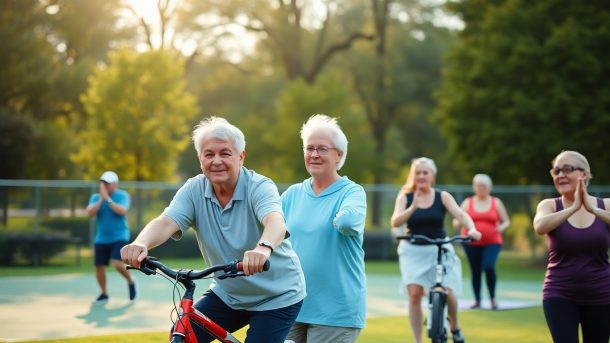There’s a world of opportunities for you to stay active and enhance your well-being as you age. Engaging in sports not only keeps you physically fit but also fosters social connections and mental sharpness. In this post, you’ll discover the best sports tailored for older adults, each offering unique benefits that can help you maintain your health and vitality. Whether you’re a seasoned athlete or a beginner, there’s something here for everyone looking to enjoy an active lifestyle.
Key Takeaways:
- Low-Impact Activities: Sports like swimming, cycling, and walking provide excellent cardiovascular benefits while minimizing stress on joints.
- Strength Training: Incorporating resistance exercises helps maintain muscle mass and bone density, which is vital as we age.
- Flexibility and Balance: Activities such as yoga and tai chi improve flexibility and balance, reducing the risk of falls and enhancing mobility.
- Social Engagement: Participating in group sports or classes fosters social connections, which can contribute to mental well-being.
- Personalization: It’s important to choose activities based on individual fitness levels and preferences to encourage long-term adherence.

Benefits of Staying Active for Older Adults
To enjoy a vibrant and fulfilling life, staying active as you age is imperative. Engaging in regular physical activities can enhance your overall well-being, ensuring you maintain strength, flexibility, and balance. Not only does physical activity improve your physical health, but it also plays a significant role in enhancing your mental and emotional state, ultimately leading to a happier, more satisfying lifestyle.
Physical Health Advantages
Older adults who participate in regular exercise experience a variety of health benefits. Staying active can help manage weight, reduce the risk of chronic diseases, and improve cardiovascular health. You may also find that consistent physical activity enhances your stamina, making daily tasks easier and more enjoyable.
Mental and Emotional Wellbeing
Adults often overlook the positive impact that physical activity can have on mental health. Staying active promotes the release of endorphins, the body’s natural mood lifters, helping to alleviate feelings of anxiety and depression. Regular exercise also contributes to better sleep patterns, which is key to maintaining a balanced emotional state.
It is widely recognized that participating in sports and physical activities can significantly boost your cognitive function. Staying engaged in active pursuits not only sharpens your mind but also provides social connections, combating feelings of loneliness and isolation. Thus, embracing an active lifestyle enriches both your physical and mental well-being, paving the way for a more fulfilling and enjoyable life.
Top Sports for Older Adults
Assuming you are seeking enjoyable ways to stay active, various sports cater to older adults’ needs. These activities prioritize low impact on joints while promoting cardiovascular health, strength, flexibility, and social interaction. From swimming to yoga, you’ll find numerous options that are not only beneficial for your physical health but also enhance mental well-being.
Swimming
Sports such as swimming provide an excellent full-body workout that is gentle on your joints. The buoyancy of water supports your body, allowing you to exercise without excessive strain. Engaging in swimming regularly enhances your cardiovascular fitness, builds muscle strength, and boosts your endurance.
Walking and Hiking
By incorporating walking or hiking into your routine, you enjoy the outdoors while reaping numerous health benefits. These activities improve cardiovascular health, boost mood, and maintain mobility, making them perfect for older adults.
A leisurely walk or a scenic hike allows you to connect with nature and can be done at your own pace. Whether you’re strolling through a park or navigating trails, these activities encourage socialization when done in groups, enhancing your overall experience. Additionally, walking and hiking can help with weight management and improve your balance and coordination over time.
Cycling
Above all, cycling is a fantastic low-impact exercise that can be easily adapted to your personal fitness level. Riding a bike, whether stationary or on a trail, promotes cardiovascular health and improves leg strength without putting too much strain on your joints.
Hence, cycling offers the advantage of being a versatile option—you can choose between solo rides for reflection or group cycling for a social outing. It not only supports your physical health but also provides an enjoyable way to explore your surroundings, thus keeping you engaged and motivated.
Yoga and Pilates
Along with providing physical strength, yoga and Pilates focus on flexibility, balance, and mental clarity. These activities are perfect for improving your posture and reducing stress through mindful movements and breathwork.
This integrative approach helps you increase core strength and mobility, which are crucial as you age. Regular practice can lead to improved balance and coordination, minimizing the risk of falls. Additionally, the meditative aspects of these disciplines contribute to overall well-being, making you feel centered and calm.
Safety Tips for Sports Participation
Unlike younger athletes, older adults require additional precautions when engaging in sports. To ensure a safe experience, consider the following tips:
- Consult with your doctor before starting any new physical activity.
- Choose activities suited to your fitness level.
- Stay hydrated before, during, and after exercise.
- Use appropriate equipment and wear suitable footwear.
- Listen to your body and stop if you experience pain or discomfort.
Knowing these safety tips can help you enjoy sports while minimizing the risk of injury.
Understanding Your Limits
Sports activities should challenge you without risking injury; therefore, acknowledging your limits is important. Recognize what your body can handle and avoid overexertion. If you haven’t been active for a while, start slow and gradually increase the intensity of your workouts. Monitor your body’s responses, and make adjustments as necessary to keep yourself safe while still staying active.
Proper Warm-Up and Cool-Down
Tips to prepare your body before and after sports participation can greatly enhance your performance and recovery. A proper warm-up increases blood flow to your muscles, preparing them for physical activity. Likewise, cooling down helps your body transition back to its resting state, reducing soreness. Incorporate gentle stretches and movement into both phases to maintain flexibility and promote overall well-being.
Safety precautions during warm-ups and cool-downs play an important role in preventing injuries. Start with light aerobic exercises to gradually raise your heart rate and loosen your muscles. Follow this with dynamic stretches that mimic the movements of your chosen sport. After your session, allow time for a cool-down that includes static stretches to ease tightness and enhance flexibility. Prioritizing these practices can significantly contribute to your overall sporting experience.

Community Resources and Programs
Keep exploring your community for various resources and programs that support active lifestyles. Local organizations often offer classes, workshops, and sports leagues specifically designed for older adults. Joining these programs can enhance your physical fitness and build valuable social connections. For insights on sport selection in middle age for longevity? : r/slatestarcodex, consider engaging in community discussions and discovering what options are available near you.
Local Sports Clubs and Teams
By participating in local sports clubs and teams, you can not only stay physically active but also foster camaraderie and a sense of belonging. Many clubs cater specifically to older adults, offering inclusive environments where you can engage in various sports at your own pace. Check local listings or community centers for opportunities to join a team in activities such as tennis, bowling, or even walking groups.
Online Platforms for Active Living
The rise of online platforms has made it easier for you to engage in active living from the comfort of your own home. These platforms offer everything from virtual workout classes to forums where you can join like-minded individuals in discussions about health and fitness. You’ll find resources tailored to varying fitness levels, ensuring that you can choose activities that suit your preferences and abilities.
Platforms dedicated to active living often provide guided workouts, fitness tracking, and educational content covering nutrition and wellness. Signing up for an online class or joining a fitness challenge can motivate you to remain consistent in your activities. Engaging in virtual communities centered around active living allows you to exchange experiences and tips, helping you stay inspired on your journey to improved health.
Motivating Factors for Older Adults
Many older adults find that staying active offers numerous benefits that keep them motivated. Consider the following motivating factors:
- Improved physical health
- Enhanced mental well-being
- Increased energy levels
- Opportunity to socialize
- Sense of achievement
The combination of these factors not only helps you maintain a healthy lifestyle but also boosts your overall happiness.
Social Engagement
The benefits of social engagement can be profound. Participating in sports or group activities allows you to meet new people, form lasting friendships, and foster a sense of community. These interactions can enrich your life and provide encouragement as you pursue fitness goals.
Setting Personal Goals
On your fitness journey, setting personal goals can significantly enhance motivation and satisfaction. When you establish clear objectives, you have a roadmap to follow, which provides a sense of purpose and direction.
Motivating your journey through personal goal setting allows you to take ownership of your progress. Begin by setting achievable goals, whether it’s walking a certain distance, joining a local sports team, or participating in a friendly competition. Regularly tracking your progress and celebrating small victories along the way will keep your motivation high, ensuring you stay engaged with your chosen activities.
Expert Recommendations
After exploring various activities, it is important to consider expert recommendations for staying active as an older adult. Engaging in low-impact sports like swimming, golf, or walking can significantly enhance your overall well-being. For more information, check out The 10 Best Sports for Seniors | Live an Active Retirement, where you’ll find tips tailored to your unique fitness journey.
Advice from Fitness Professionals
The best advice from fitness professionals emphasizes listening to your body and prioritizing enjoyment in your chosen activities. By selecting activities that resonate with you, you’ll be more likely to remain committed and active over time.
Success Stories from Older Athletes
Expert insights reveal that many older athletes have achieved remarkable feats while embracing sports in their later years. Their experiences can inspire you to take up an activity that suits your interests and abilities.
Athletes like 92-year-old marathon runner Fauja Singh and swimmer Diana Nyad, who completed a historic swim at age 64, showcase how you can redefine age limits through sports. These inspiring stories illustrate the myriad of possibilities that await you, proving that it’s never too late to pursue your athletic passions.
Conclusion
To wrap up, engaging in sports is an excellent way for you to maintain your physical health and enhance your overall well-being as you age. Activities like swimming, golf, and walking are not only enjoyable but can also keep you active and socially engaged. For more insights on the best sports suited for older adults, consider exploring the link for the Best Sports For Older Adults, According To Experts. By participating in these activities, you can create a fulfilling and healthier lifestyle.
Q: What are some low-impact sports suitable for older adults?
A: Low-impact sports are ideal for older adults as they minimize the risk of injury while still providing health benefits. Some excellent options include walking, swimming, cycling, and tai chi. Walking is easily accessible and can be done at one’s own pace. Swimming is gentle on the joints and provides a full-body workout. Cycling, either on a stationary bike or outdoors, offers cardiovascular benefits with low strain. Tai chi enhances balance and flexibility while promoting relaxation and mental well-being.
Q: How can older adults get started with sports or physical activities?
A: Starting a new sport or physical activity involves setting realistic goals and progressively building endurance. It’s a good idea for older adults to consult with a healthcare provider before beginning any new activity, especially if they have existing health concerns. Picking a sport of interest can make the process enjoyable. Begin with short sessions, gradually increasing duration and intensity while paying attention to body signals. Joining group classes or community programs can provide support and motivation, making it easier to stay committed.
Q: What are the benefits of staying active through sports for older adults?
A: Participating in sports offers numerous benefits for older adults, including improved physical health, enhanced mental well-being, and increased social interaction. Regular physical activity helps in maintaining mobility, flexibility, and strength, reducing the risk of chronic illnesses. Mentally, staying active can boost mood and cognitive function, decreasing feelings of anxiety and depression. Furthermore, engaging in sports often leads to meeting new people, fostering friendships, and building a sense of community, all of which contribute to overall life satisfaction.

